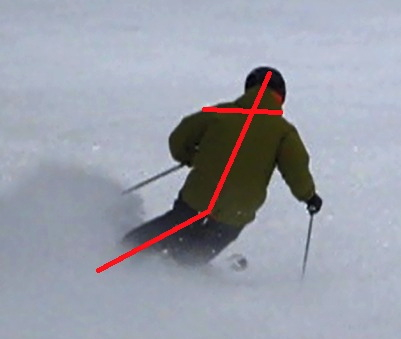 Last month I made a connection between intermediate skiing and geometry. This applies to advanced skiers and to take it a step further, I’ll add physics to the mix.
Last month I made a connection between intermediate skiing and geometry. This applies to advanced skiers and to take it a step further, I’ll add physics to the mix.
There are two ways to put your skis on edge. The first method, inclination, uses the whole body. Angulation, the second method, creates angles by using our hips and knees joints.
When skiing at speed we can tip our whole body relying on centrifugal force to hold us up. These banked type turns can be fun in a cruising type mode but will not allow for very good edge hold as the edge angle created can only be as large as the amount of body tip.
When we tip using our hip joint and keep our upper body upright so that our shoulders are level to the horizon, we can create a much larger edge angle. In this way we utilize our most powerful joint which is surrounded by a web of powerful muscle.
This allows us to resist the forces that want to both tip us up hill while pulling us off our round turn shape and ultimately hold a better edge. Angulation in your knees should only be used to fine tune things as those joints are much weaker and fragile and offer less range of motion than our hips.
So how do we create these angles in our bodies? Most intermediates are already banking turns. The hips are tipped-in along with the rest of the body so all we need to do is get the shoulders level and create a nice powerful angle. Recently I noticed my son was tipping in too much with his upper body. He is NYSEF trained and knows how to correct this.
The video above illustrates a great drill that racers use to improve their ability create angles in the body. Put your poles behind your back and try to keep them level with the horizon as you make medium to large turns.
Try this first on green trails and work your way up to blues. Do a run with the poles behind you and then without poles. Work to keep the your shoulders level. I find it helps to think about raising the upper shoulder in the bottom part of the turn to keep them level. (Side hills will change your horizon somewhat.)
Once you get the hang of this you will notice an improved ability to hold your edge and line on steeper slopes and firmer snow. Angulation is one of the keys to advanced level skiing in any snow condition so use physics to your advantage out on the mountain.

Sweet drill! I wish I practiced this today, I guess it might have to wait until next weekend. The soft spring snow is so great to practice on. Actually, spring corn is great for everything!
Great!
I talk about physics and skiing too but mostly about about the peeds and energies.
Will check out in more detail later.
When I raced, we used a different version of this drill putting our poles in front of our bodies in front of our sternum. The goal was to keep the poles parallel with your shoulders which should be squared down the hill. It gives a visual as you can see the poles tipping which suggests that your shoulders are doing the same.
The problem with both of these drills is you can still “think” you are doing it right but really doing it wrong or only slightly better than before. Without getting feedback, you could just be engraining what you “think” is the correct feel but still far from it.
My all time favorite way to drill getting my shoulders squared with appropriate angles is finding a slope with the sun exactly at my back so I can watch my shadow. Whenever I see my shadow directly in front of me, I follow it and instantly go into technique practice mode.
Two other aspects to this, the banked turn does not allow you to quickly move your skis from edge to edge as your body needs to straighten. In all sports the true athlete finds thee most efficient way to move. Another problem with the banked turn, if your edges slip on the ice the forces that are hold you up are gone and you go down, the angulated turn allows you to easily engage the inside edge and stay over your skis riding out the slip. Large angles take strength and flexibility as the forces can build rapidly. This is where time in the gym working on core helps
Dan – so true – this is why we do all those core workouts
http://nyskiblog.com/preseason-ski-workout/